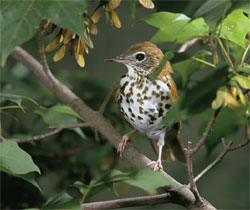

Play wood thrush song.
Recording: Bruce Reid.
HABITAT DESCRIPTION
As much as 90 or more of Mississippi’s upland forest habitats have been “severely
degraded or lost and the condition of the remaining (tracts) could only be regarded
as fair,” according to the state Comprehensive Wildlife Conservation Strategy (2005). Forest
types vary from pure hardwood stands to mixed hardwood-pine stands to stands dominated
by loblolly pines. Upland hardwood and pine forests are found throughout most of
Mississippi, except in the Delta counties. Upland forests cover roughly 5 million
acres in Mississippi (excluding commercial pine plantations), but have been reduced
greatly. Dry longleaf pine forests and beech/magnolia forests are considered critically
imperiled in the state; dry hardwood forests, loess forests and moist longleaf pine
forests are considered imperiled.
WILDLIFE MISSISSIPPI PROJECTS
- Wildlife Mississippi’s focus is on protecting, restoring and enhancing forest stands
that have been converted to loblolly pine plantations and are not as economically
productive as mixed stands.
- Promotion of the Conservation Reserve Program and other incentive programs for restoration.
- Pursuit of policy changes to allow more conservation.
- Development of incentives for private landowners to protect, restore and enhance
longleaf pine.
POPULAR SPECIES
White-tailed deer, wild turkey, squirrels, barred owl, red-tailed hawk and red-bellied
woodpecker.
SPECIES OF CONCERN
Species of concern are numerous, depending on forest type. In imperiled and critically
imperiled forest types, they include Mississippi gopher frog, various snakes and
lizards, various bats, red-cockaded woodpecker, northern bobwhite and various nesting
forest birds such as wood thrush, Swainson’s warbler and worm-eating warbler.
BENEFITS
- Well-managed tracts can yield good economic returns to private landowners.
- Upland forest corridors are important migratory routes for forest-dwelling birds.
- Well-managed sites can have sustainable populations of white-tailed deer, squirrels,
wild turkey and northern bobwhite.
- Nature study opportunities abound.